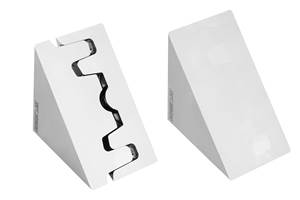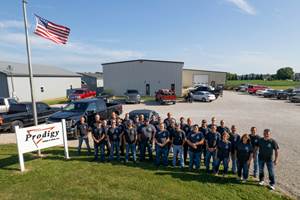High-Speed Machining of Hardened Die and Mold Steels: A Total Concept
HSM of hardened die and mold steels is a proven concept composed of several components - all contributing to the cost-efficient machining of those specific materials.
Q: What is high-speed machining (HSM) of hardened die and mold steels?
A: HSM of hardened die and mold steels is a proven concept composed of several components - all contributing to the cost-efficient machining of those specific materials.
HSM of hardened die and mold steels is not simply accomplished by increasing the rpms of a conventional machining center. A machining center that has been modified to increase rpms (spindle multiplier, etc.), but does not have the memory ability to program long, complex toolpaths; does not have the "look ahead" features related to machine acceleration characteristics; and lacks the rigidity to perform high-speed functions, will not provide the shop owner with cost-effective HSM.
A number of machine tool manufacturers, recognizing the need for cost-effectively performing HSM of hardened die and mold steels, have designed, developed and manufactured machining centers capable of performing the required functions. These proven machines have the programming ability, spindle rpm, related feedrate requirements, spindle bearings and other necessary components to perform effective and efficient HSM operations. They are, as one manufacturer states, "built from the ground up." The end result being that the die and mold shop, whose capital investment has provided them with a high-speed machining center of a size and style required for their applications, now has the solid basis for increased productivity.
Other Components
The high-speed machine is, by far, the largest part of the overall expenditure required in HSM of hardened die and mold steels. However, other components required in cost-effective HSM must be carefully reviewed. They include CAD/ CAM, tool holding, coolant, clamping and cutting tools.
These other components are extremely important and if it were an ideal world, a shop owner would have a simultaneous conference with the machine tool manufacturer and representatives from the above list. However, in reality it would be extremely difficult, if not impossible, to organize a conference of this magnitude. So, what is the alternative?
Once you have decided to enter into HSM of hardened die and mold steels, begin speaking with representatives of the above listed components. Do not let yourself become focused on the machine tool. The other components of HSM will definitely increase the productivity of your machining center.
The machine tool manufacturer has had experience with the other representatives, so his suggestions regarding who to contact are good starting points. Your best results will come from searching and researching until you are satisfied with a combination of answers that support the overall concept of HSM.
HSM Strategies
If selecting a machine tool that is truly designed for HSM is an absolute requirement (and it is), then selecting a cutting tool designed for HSM also is an absolute requirement (and it is).
The end mill used for HSM of hardened die and mold steels is designed and manufactured with a specific combination of carbide substrate, strength, grinding accuracy, tool geometry and coating. It differs as dramatically from the standard end mills used in conventional machining operations as does the high-speed machining center differ from the conventional machining center. The most noticeable difference in the HSM end mill is that it has a short flute length of approximately 1:1 or 1.5:1 vs. cutting diameter. This design increases tool mass, which in turn, increases the end mill's rigidity at high cutting speeds and feeds.
In addition to the design of the HSM end mill, specific machining strategies are used to maximize the metal removal rate of the end mill while providing increased tool life. These strategies have been developed through in-house application research of HSM in hardened die and mold steels, and in constant field testing and upgrading of those applications.
Applying these strategies will provide increased productivity through maximizing the performance of the HSM end mill and the machining center.
Since specific abbreviations will be constantly used in the HSM strategies of this text. For reference purposes, they are explained in Chart I.
With HSM hardened die and mold steels, the arc of contact is governed by the radial width of cut (Ae). The arc of contact is the angle (at the center of the end mill) formed by the two points, beginning where the cutting edge enters the cut to where the cutting edge exits the cut. It is calculated as per the following formula:
a = arccos [(R-Ae)/R]
a - arc of contact angle
R - radius of the end mill cutting diameter
Ae - radial width of cut
As the Ae increases, the arc of contact increases, and the end mill's cutting edges stay in the cut for a longer period of time, causing increased heat in the tool. Because of this, the Ae should always be limited as indicated by the information in Chart II.
The Axial HSM Strategy
The axial HSM strategy requires the depth of cut to be many times larger than the width of the cut. Milling in this manner results in less radial contact between the tool and the part. Per revolution, the teeth have more time to cool down and less time to heat up because of the reduced contact time with the material being machined.
This strategy should be used in place of face milling wherever possible. The rate of material being removed will equal or exceed face milling and the tool life will be increased, primarily due to limited heat build-up from the small arc of contact of the tool (see Figure 1 and Chart III).
The HSM Peel Strategy
The HSM peel strategy is very similar to the axial HSM strategy and is used for milling a slot into the material. By maintaining a limited radial width of cut (Ae), the arc of contact also is minimized. In conjunction with proper feeds and speeds, the end mill can remove a large amount of material without the generation of excessive heat that contributes to tool wear.
The width of the slot must be proportionately larger than the diameter of the end mill as indicated in Chart IV.
The HSM Push-Pull Strategy
The HSM push-pull strategy is an excellent strategy for profile milling. It utilizes, as close as possible, the entire cutting edge of a ball end mill. This strategy distributes tool wear along the entire radius end as well as the sides of the flutes. This distribution of tool wear increases the life of the tool.
When using the HSM push-pull strategy in roughing operations, tool life is extended by 2X over normal axial machining. For finish operations, tool life is slightly less than roughing, but still greater than normal axial machining. In either case, metal removal is greatly increased. This strategy is merely axial milling in a vertical, circular movement (see Chart V).
The HSM Helix Strategy
The HSM helix strategy is used for vertical milling into the material - i.e., to begin cavity machining. Once the I.D. is machined, other strategies can be employed to increase the diameter, form, etc.
The minimal I.D. machined is governed by the size of the end mill being used, as illustrated in Chart VI.
The vertical feedrate (a helical ramping feed) is directly related to the hardness of the material being machined and the diameter of end mill used. This is illustrated in Chart VI as Ap/360x.
The Ramping HSM Strategy
The ramping HSM strategy is used for milling a slot (or other similar) form into the material when entry must be accomplished from the top of the part. The intent is to ramp into the face of the material as a means of machining the slot to a specific depth. Other strategies can then be applied to machine the slot to the desired configuration (see Chart VII).
The Surface (Face Milling) HSM Strategy
The surface (face milling) HSM strategy is basically the opposite of axial HSM because the width of the cut is many times greater than the depth of the cut. Heat build-up is the major problem with this type of milling due to the very large arc of contact with the material being machined (see Figure 2 and Chart VIII).
The Slot Milling HSM Strategy
The slot milling HSM strategy involves using the full diameter of the end mill in the material. The teeth will build up heat during 50 percent of the revolution, and are in constant contact with the part. Consequently, there is very little time for the cutting teeth to cool down and tool life is drastically reduced. Additionally, because the entire cutter diameter is being used, one side is conventional milling and the other side is climb milling. This causes increased radial forces on the climb milling side (see Figure 3 and Chart IX).
All of the strategies illustrated and explained in this article will - at one time or another - be required in the HSM of hardened die and mold steels. However, the practice of applying the strategies that can efficiently remove material while providing excellent tool life should be prioritized. For most part, they are the strategies that can be governed by maintaining a specific arc of contact.
Since each machining application, including type of material, hardness, depth of cut, end mill size, etc. must be considered when providing related feeds and speeds, it is impossible to make recommendations within this text. However, this information can readily be provided on an application by application basis.
The total concept of HSM is growing rapidly, and supported by a constantly evolving technology, it is providing excellent benefits to the die and mold industry now and in the future.
We would like to thank Jabro Tools of The Netherlands for their assistance in this article.
Related Content
How to Machine Micron-Level Precision Molds in One Try
On-machine measurement intelligence and modification technology helps mold builders overcome machining variables and quickly produce micron-level tolerances.
Read MoreMold Builder Gains Higher Accuracy, Repeatability, Productivity from Milling Machine
Very high stability, precision, thermal and vibrational control, and low cost of ownership led Diamond Tool & Engineering to purchase a high-precision, high-speed three-axis milling center.
Read MoreBringing Market-Specific Engineering Experience to Every Project
Experience, acumen and attention to detail help Prodigy Mold & Tool create value and build long-lasting customer relationships.
Read MoreCeramic End Mills Excel in High-Speed Roughing, Milling of Heat-Resistant Superalloys
Long-lasting, five-flute Cera-Cut end mills introduced by Emuge-Franken USA are designed to consistently tackle high temperature resistant metals and hardened tool steels.
Read MoreRead Next
Causes of High-Speed Machining Irregularities
A series of high-speed machining trials to machine the core of a mobile phone to near finished quality reveals the causes of flaws in the surface quality.
Read MoreReasons to Use Fiber Lasers for Mold Cleaning
Fiber lasers offer a simplicity, speed, control and portability, minimizing mold cleaning risks.
Read MoreHow to Use Continuing Education to Remain Competitive in Moldmaking
Continued training helps moldmakers make tooling decisions and properly use the latest cutting tool to efficiently machine high-quality molds.
Read More




















_300x250 1.png;maxWidth=300;quality=90)


.jpg;maxWidth=300;quality=90)
















